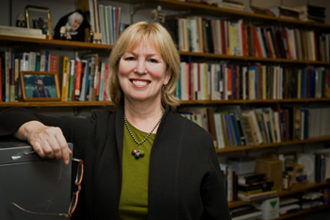Historian Unmasks Quadroon Myth
Historian Emily Clark has been here before, plowing through New Orleans archival documents from the early 1800s, handwritten in French. Her latest search has unveiled truths about a group of women that Clark says history has maligned: free women of color.

Women in Colonial history are a frequent subject of historian Emily Clark. Her first book was Masterless Mistresses: The New Orleans Ursulines and the Development of a New World Society, 1727â“1834. (Photo by George Long)
“I want to bring them to the attention of history again,” says Clark, an associate professor who holds the Clement Chambers Benenson Professorship in American Colonial History at Tulane.
Funding from a state Awards to Louisiana Artists and Scholars (ATLAS) grant has allowed Clark to extend a sabbatical and work on a new book, The Strange History of the American Quadroon.
Myths abound about “quadroon balls” in early-19th-century New Orleans in which quadroons described by Clark as “a name for any woman who seemed to be of mixed race” were presented to groups of white men. With marriages between the two groups forbidden, what supposedly resulted was plaçage, a contractual living-together arrangement.
But when Clark went looking in the archives, she found something else.
Seeking out marriage records of the Archdiocese of New Orleans and the Notarial Archives, Clark has discovered that in the 1820s, the city's free women of color got married at the same rate as white women. “These were young free women of color whose families had been rooted in New Orleans for generations,” she says.
But another group of free women of color in the city, Haitian refugees, had a different experience. Their survival strategies may have given rise to the myths of the quadroon balls and plaçage.
The myth that grew up around quadroon balls, described vividly in newspaper and traveler's accounts of the day, was the origin of the city's first sexual tourism industry and eventually involved bringing women here from other cities, Clark says.
“This whole myth doesn't describe at all the free women of color in New Orleans,” she says, many of whom married, were mothers, owned property and were pillars of their community. Clark's book on this subject is due out in 2013.
